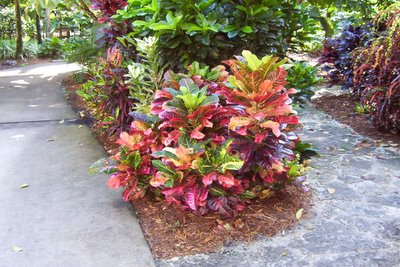Croton Care

Also known as variegated Laurel, Crotons come from the South Pacific Islands. The habit of growth varies with the type of plant. Dwarf croton varieties are bushy and compact. The tree-like varieties are tall and have a good spread. Crotons are usually maintained at two to three feet, but if given the opportunity, they can grow into large trees.
Caring for a croton is not simple and requires both knowledge and experience. Basic prerequisites are plenty of light, suitable temperature, adequate watering and plenty of humidity in the atmosphere.
To start, crotons need plenty of light in order to maintain its intense colors although new varieties do quite well in lower light. Lots of light and moderate temperatures are the factors that will ensure your plant has vivid colors and quick growth. In other words, the more the light your plant gets, the more beautiful and vivid the colors of its leaves. During the winter you can allow some direct sunlight on your plant, but keep it at 2-3 hours daily. If more, then you will risk sun-burning of the leaves while during summer you should only provide filtered light.
Crotons cannot stand either too high or too low temperatures (the ideal temperature is around 20οC). So, make sure to avoid fluctuations of temperature and keep the pots away from drafts. If the temperature has such ups and downs you will see leaves, in different parts of the plant, drop. Generally, if the temperature is too low your plant may drop all of its leaves in no time.
If you notice lower leaves dropping, or if the leaves colors are dull and you also get brown tips, it is possible that your plant needs more humidity.
Provide humidity by spraying the leaves with lukewarm water as often as you can, even daily if you can spare the time. Use a humidifier or place the pot on a tray with wet pebbles so that the plant will absorb the necessary humidity.
Usually during summer, although light is more than adequate, the high temperatures may fade the colors of the leaves. To avoid this, in summer move your pot to the coolest spot of your home and cut down on fertilizing as over-fertilizing can have the same effects as high temperatures. The growth of the plant slows down in winter, when the plant rests, but the colors of its leaves remain as bright if light is adequate.
You should fertilize every couple of months, using liquid fertilizer, from spring till fall while you should not add any fertilizer during
Light
Different varieties have differing light requirements. Some crotons thrive in full sun, while others do best in semi-shade to full shade. In general, the more sunlight received by the foliage, the brighter the colors will be. The light requirement indoors is usually about six to eight hours of light. Plants placed in east or west windows do best, but should not be exposed to direct sunlight coming through the glass. Crotons respond well to artificial light from gro-lites.

Water
Keep crotons lightly moist at all times. Never let your croton dry out completely, which cause foliage to drop. Foliage should be misted at least two to three times per week. Do not over-water or allow the plant to sit in water.
Temperature
Crotons require warm, moist conditions with a minimum winter temperature of 60 degrees. Changes in climatic conditions should be made gradually to avoid defoliation.
Soil
Good drainage is necessary. Use quality potting soil.
Fertilizer
Fertilize frequently and lightly with a balanced soluble food for houseplants or trees and shrubs.
Pests
Scales, thrips, mealy bugs and spider mites are some of the more common pests. Preventative treatment is advised. Spray at least once a month. Always use a spreader sticker with the insecticide. If spider mites are detected, make three applications of a recommended miticide at five-day intervals. Timing of spraying is crucial for killing the egg hatch.







0 Comments:
Post a Comment
<< Home